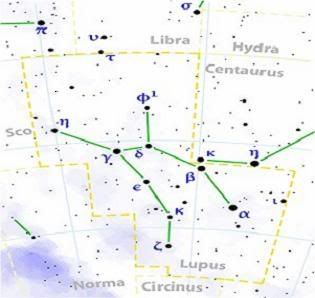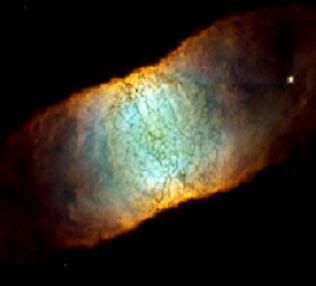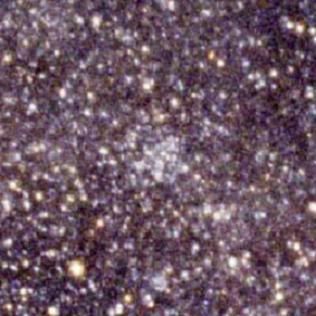Post by glactus on Feb 17, 2008 7:32:59 GMT

Lupus,( Latin: wolf) is a southern constellation between Centaurus and Scorpius. This constellation seems to have been an unidentified animal for both the Greeks and Romans, simply known as Therion. Both cultures thought Centaurus was offering this animal as a sacrifice. By the time Johann Bayer published his catalogue of constellations in the early seventeenth century, the animal was considered a wolf.
Notable stars:
Alpha Lupi (a betaCephei variable) is the brightest star in the constellation at 2.3 magnitude. There is some dispute over its distance; some authorities put it at 430 light years, while others at around 620. From the absolute magnification of - 4.4, it would have a distance of 710 light years.
b(beta) Lup is a magnitude 2.62 beautiful blue-white star 524 light years away.
g (gamma) Lup is a magnitude 2.97 blue-white star 567 light years away.
k (kappa) Lup is an easy double star for small telescopes. A bright pale yellow pair of stars of magnitudes 3.88 and 5.70 dominate a striking field. The system lies 182 light years away.
Notable images:

IC 4406
A dying star, IC 4406, dubbed the "Retina Nebula" is revealed in this Hubble Heritage image. Like many other so-called planetary nebulae, IC 4406 exhibits a high degree of symmetry; the left and right halves of the Hubble image are nearly mirror images of the other. If we could fly around IC 4406 in a starship, we would see that the gas and dust form a vast donut of material streaming outward from the dying star. From Earth, we are viewing the donut from the side. Magnitude is 11.0 and distance from Earth is 1,900 light years.

NGC 5643
5643 is a Type 2 Seyfert galaxy with an interesting velocity field which reveals the high-excitation gas to be distributed within a well-defined V-shaped structure, presumably the projection of a three-dimensional cone. There is evidence that the fine-scale structure of the ionized gas is related to the radio ejecta, which share the same axis as the cone, and a dust lane straddling the nucleus is detected. Magnitude is 10.2 and distane from earth is 38,000 light years.

NGC 5882
NGC 5882, was reported by Wilhelmina Fleming as a Type V star as IC 1108 in the Astronomische Nachrichten Vol. 135, p.195, 1895. The position and object was then re-classified by Fleming indicating that she is referring to the same object as the NGC 5882 planetary nebula. Magnitude is 10.5 and distance from Earth is 45,000 light years.

NGC 5822
NGC 5822 is a very large open cluster of about a hundred stars and is 6,000 light years away. the cluster is located about 3 degrees SW of Zeta Lupi. Magnitudeis 6.5

pulsar
credits:
Lupus map: wikipedia
en.wikipedia.org/wiki/Lupus_(constellation)
image: IC 4406: fotografiji3
www.ad-loznica.org.yu/fotografije3.htm
image NGC 5643:
www.spiral-galaxies.com/Galaxies-Lupus.html
image: NGC 5882: Original source - HST/NASA/ESA.
en.wikipedia.org/wiki/NGC_5882
image: NGC 5822: allthesky
www.allthesky.com/constellations/centaurus/dsos.html


